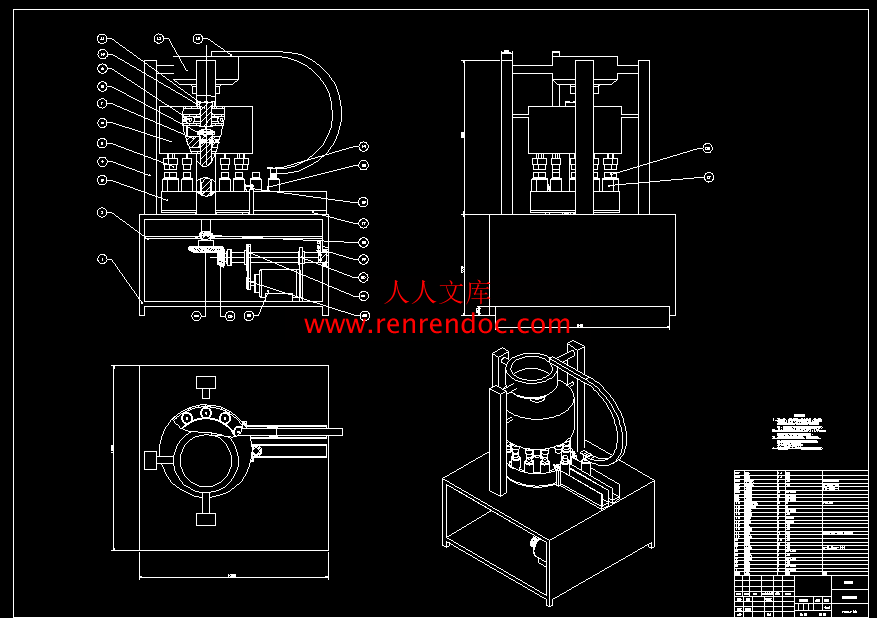液体灌装生产线上拧瓶盖机的设计
37页 13000字数+说明书+任务书+开题报告+外文翻译+9张CAD图纸【详情如下】
PDF打印图.rar
Print2CAD-chilunda.dwg
Print2CAD-chilunxiao.dwg
Print2CAD-dailunda.dwg
Print2CAD-dailunxiao.dwg
Print2CAD-zhuangpan.dwg
Print2CAD-zhuichilunda.dwg
Print2CAD-zhuichilunxiao.dwg
Print2CAD-zhuzhou.dwg
Print2CAD-zongzhuangpei.dwg
任务书.doc
外文翻译--螺杆式压缩机.doc
液体灌装生产线上拧瓶盖机的设计开题报告.doc
液体灌装生产线上拧瓶盖机的设计说明书.doc
计划周记进度检查表.xls
摘要
回转式拧瓶盖机适用于带螺纹的盖与瓶的旋盖,市场上现有的回转式拧瓶盖机大多数是半自动的包装机,瓶盖的疏理大多由人工来完成,生产效率不是很高,而且加大了劳动的强度,再生产时有一定的危险,本设计为自动理盖而且是多工位拧盖机。
本文介绍了题目的研究背景和意义,论述了拧盖机在国内外的发展状况,介绍了本次设计研究的内容及方法。本次设计的重点是拧盖机的总体设计方案、过程的拧盖、输送方式和定位方法,在此基础上进行了运动与结构的设计。本次设计采用的拧盖方法是回转式的,是通过圆柱凸轮的轮廓线来实现拧盖头的上下往复运动的,通过锥齿轮传递转矩;而且在满足拧盖机原理的条件下,充分考虑了整机的布局和经济性,不但结构简单明了,操作方便而且本课题的设计实现了从进瓶到出瓶的全部自动化,具有速度可调、定位准确、旋盖可靠、运行平稳、无噪音和不伤瓶盖等优点,克服了传统机构的缺点,总体上达到了我们预期设计的目标。
关键词:拧瓶盖机构;理盖机构;传送;自动化;转盘
目录
摘要III
AbstractIV
1 绪论1
1.1 本课题的研究内容和意义1
1.2 国内外的发展概况1
1.3 本课题应达到的要求1
2 总体方案设计2
2.1 方案一的介绍2
2.2 方案二的介绍2
2.3 方案比较2
2.4 采用方案的详细设计3
2.4.1 上盖装置的设计3
2.4.2 传送带的设计4
2.4.3 底座箱的设计4
2.4.4 拧盖机构的设计4
2.4.5 转盘的设计5
3 总装图的确定6
3.1 主要技术参数的确定6
3.1.1 电机的选择6
3.2 传动方案的确定7
3.3 结构方案的确定7
4 部件装配图的确定9
4.1 带传动的计算9
4.2 轴的设计计算和校核11
4.2.1 轴的结构设计及选材11
4.2.2 轴的设计计算11
4.2.3 轴的校核计算12
4.3 齿轮的计算和校核12
4.3.1 齿轮材料处理工艺及制造工艺的选定12
4.3.2 确定各主要参数13
4.3.3 传动比13
4.3.4 齿轮模数m13
4.3.5 齿轮接触疲劳强度计算13
4.3.6 齿轮强度校核14
4.4 锥齿轮的计算和校核19
4.4.1 选取齿轮类型,精度等级,材料及齿数19
4.4.2 按齿面接触强度设计19
4.4.3 设计计算19
4.4.4 按齿根弯曲强度设计20
4.4.5 设计计算21
4.4.6 几何尺寸计算22
4.5 键的计算和校核23
4.5.1 键的选择计算23
4.5.2 键的校核23
4.6 轴承的选择和校核23
4.6.1 轴承的选择23
4.6.2 轴承的寿命计算24
5 拧盖机的工作情况简介26
5.1 传送及拧盖部分26
5.2 控制部分26
6 拧盖机的安装、维护和安全28
6.1 安装28
6.2 维护保养28
6.3安全要求28
7 结论与展望29
7.1 结论29
7.2 不足之处及未来展望29
致 谢30
参 考 文 献31
1 绪论
1.1 本课题的研究内容和意义
拧盖机是自动灌装生产线的主要设备之一,用于玻璃瓶或PET瓶的螺纹盖封口。随着社会的发展和人民生活水平的提高,人们对产品的包装质量的要求也越来越高。由于螺纹盖具有封口快捷,开启方便及开启瓶后又可重新封好等优点,使其在许多产品的包装中应用越来越广泛,诸如饮料,酒类,调味料,化妆品及药品等瓶包装的封口就大量采用螺纹盖封口。目前现有的国产同类机型的封盖机的产量,速度和自动化程度都相对落后。为了适应现代包装机高速,高效和高可靠性生产的需要,研制了一种回转式拧盖机,该机采用多工位回转式结构,机电气一体化,具有效率高,速度快,可靠性好和自动化程度高等优点。
包装机械为包装工业提供装备机械,影响着各类包装制品工业的技术水平和产品档次,制约着包装工业的发展和速度。长期以来,我国包装机械行业非常薄弱,形不成规模和水平,致使我国包装工业发展极慢。我国包装机械行业在历经了七十年代的起步,八十年代的发展,九十年代由于包装制品发展的需要而实现了高速度发展,但是由于起步迟,起点低,规模小,我国包装机械总体水平要比发达国家落后20年,国内目前需求量的60%,尤其是技术含量高的技术装备依赖进口。对于包装制品工业,包装机械是我国包装工业的优势。
1.2 国内外的发展概况
提高自动化程度是包装机械发展重要的趋势。产品和产量居世界之首的美国十分重视白装机械与计算机紧密结合,实现机电一体化控制,将自动化操作程序、数据收集系统、自动检验系统更多用于包装机械之中。日本则长于微电子技术,用以开那个值包装机械,有效地促进了无人操作和自动化程度的提高。在计量、制造和技术性能等方面居于世界领先地位的德国也高度重视提高自动化程度。几年前,德国包装机械系统设计时,自动化技术在整个系统操作及运行中还占30%,现在已占到50%以上。
1.3 本课题应达到的要求
目前国内液体灌装生产线中广泛使用的旋开封盖口机大多为直线式拧盖机,为了适应现代包装机高速、高效和高可靠性生产的需要,在广泛吸收国内外先进机型的基础上,设计此了机器。该拧瓶盖机采用回转式结构。本次设计是针对回转式拧盖机整体的设计。主要工艺流程包括:供瓶+供盖—旋盖—输送。同时要求熟练的操作UG软件,进行建模,绘制图3D模型并出图纸。
2 总体方案设计
2.1 方案一的介绍
如图2.1所示,该方案利用步进电机带动传送带将待旋盖瓶传送至上盖装置下方自动上盖并抚平,然后将上好盖的瓶子停止在旋盖机正下方,传感装置将信号传至旋盖机构,通过上部的气缸实现旋盖头的整体下移,通过下部的杠杆机构实现瓶子的夹紧,选盖头旋转将瓶盖旋紧在瓶上。旋盖完成后旋盖头升起,传送带继续前进一定距离,开始重复旋盖过程。本方案结构较为简单、易懂,但是从整体来分析,旋盖的效率不是太高,而且对传送带的各种要求比较高,需要特别订制,成本会提高。

 川公网安备: 51019002004831号
川公网安备: 51019002004831号